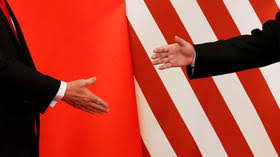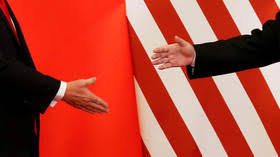
China has made a huge commitment of purchasing from the United States under the phase one of the trade agreement which has sent commodity traders and analysts wondering hot Beijing will be able to achieve the targets.
Over a period of two years, China will be purchasing more agricultural products from the US worth $32 billion compared to the 2017’s $24 billion baseline while also pledging to increase purchase of US energy by more than $50 billion, claimed reports citing sources. The phase one trade agreement also mandates an additional $80 billion of Chinese purchases of US manufacturing products.
Those purchases will bring down the approximately $300 billion trade deficit that the US has with China. However there are questions being raised by analysts and experts who keep a watch on Chinese commodity flows about how Beijing will be able to absorb such huge quantities of American products without jeopardizing its relations with other suppliers of the same products. Analysts believe that such huge imports will also hurt China’s domestic producers and manufacturers as well as force Beijing to make significant changes to standards and quotas for imports.
“Either China massively increases imports and reduces current account surplus from the current 1.5% of GDP, or it engages in trade diversion away from current providers of goods which compete with the U.S.” said Alicia Garcia Herrero, Chief Economist Asia Pacific at Natixis in Hong Kong. “I see this second scenario as much more likely.”
According to reports, in order to meet the pledge for US energy imports, China will need to import petrochemical raw materials such as ethane and liquefied petroleum gas (LPG) from the US as well as crude, liquefied natural gas (LNG).
However, it would be an issue unless it signs new supply deals that can replace the other exporters, said reports.
Seng Yick Tee, an analyst at SIA Energy in Beijing, said that the $50 billion target is “too aggressive and unlikely to achieve”. Tee added that in 2017 and 2018, China imported about $8 billion worth of energy product exports from the United States. “To achieve $25 billion a year, all the imports need to be tripled,” Tee said.
“Most of the Chinese refineries were designed to process medium-sour crude, but U.S. oil is mostly light, sweet,” SIA’s Tee said, referring to the density and the sulfur amounts in crude, which dictate the types of fuels that can be refined from an oil.
According to experts quoted in recent reports, the promise by China of increasing purchase of US agricultural products by more than $30 billion over two years is “shocking” because the increment itself is more than what China has imported such products from the US in any single year.
“It would make (more) sense if the $32 billion is the total number, not the increased number,” said reports quoting experts.
According to Iris Pang, Greater China economist at ING in Hong Kong, if such a huge amount of agricultural and farm products are purchased from just one supplier, it could disrupt the supply chain and twist international crop prices.
“Prices of agri (commodities) from the rest of the world could be cheaper, especially after China cut import tariffs (in January). So even after retaliatory tariffs are removed, the U.S. will not have a competitive advantage over other economies,” she said.
(Source:www.reuters.com)
Over a period of two years, China will be purchasing more agricultural products from the US worth $32 billion compared to the 2017’s $24 billion baseline while also pledging to increase purchase of US energy by more than $50 billion, claimed reports citing sources. The phase one trade agreement also mandates an additional $80 billion of Chinese purchases of US manufacturing products.
Those purchases will bring down the approximately $300 billion trade deficit that the US has with China. However there are questions being raised by analysts and experts who keep a watch on Chinese commodity flows about how Beijing will be able to absorb such huge quantities of American products without jeopardizing its relations with other suppliers of the same products. Analysts believe that such huge imports will also hurt China’s domestic producers and manufacturers as well as force Beijing to make significant changes to standards and quotas for imports.
“Either China massively increases imports and reduces current account surplus from the current 1.5% of GDP, or it engages in trade diversion away from current providers of goods which compete with the U.S.” said Alicia Garcia Herrero, Chief Economist Asia Pacific at Natixis in Hong Kong. “I see this second scenario as much more likely.”
According to reports, in order to meet the pledge for US energy imports, China will need to import petrochemical raw materials such as ethane and liquefied petroleum gas (LPG) from the US as well as crude, liquefied natural gas (LNG).
However, it would be an issue unless it signs new supply deals that can replace the other exporters, said reports.
Seng Yick Tee, an analyst at SIA Energy in Beijing, said that the $50 billion target is “too aggressive and unlikely to achieve”. Tee added that in 2017 and 2018, China imported about $8 billion worth of energy product exports from the United States. “To achieve $25 billion a year, all the imports need to be tripled,” Tee said.
“Most of the Chinese refineries were designed to process medium-sour crude, but U.S. oil is mostly light, sweet,” SIA’s Tee said, referring to the density and the sulfur amounts in crude, which dictate the types of fuels that can be refined from an oil.
According to experts quoted in recent reports, the promise by China of increasing purchase of US agricultural products by more than $30 billion over two years is “shocking” because the increment itself is more than what China has imported such products from the US in any single year.
“It would make (more) sense if the $32 billion is the total number, not the increased number,” said reports quoting experts.
According to Iris Pang, Greater China economist at ING in Hong Kong, if such a huge amount of agricultural and farm products are purchased from just one supplier, it could disrupt the supply chain and twist international crop prices.
“Prices of agri (commodities) from the rest of the world could be cheaper, especially after China cut import tariffs (in January). So even after retaliatory tariffs are removed, the U.S. will not have a competitive advantage over other economies,” she said.
(Source:www.reuters.com)





